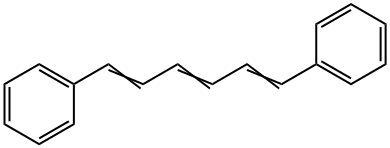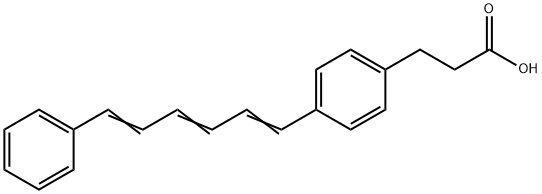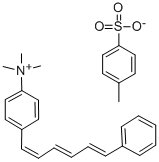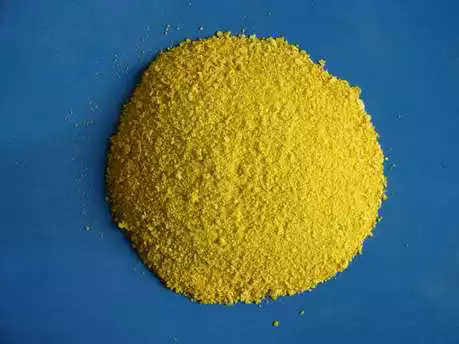1,6-DIPHENYL-1,3,5-HEXATRIENE
Synonym(s):5-(1,3-diaryl-1H-pyrazol-4-yl)hydantoin;5-[3-(4-fluorophenyl)-1-phenyl-1H-pyrazol-4-yl]-2,4-imidazolidinedione;Dicinnamyl;DPH
- CAS NO.:1720-32-7
- Empirical Formula: C18H16
- Molecular Weight: 232.32
- MDL number: MFCD00004793
- EINECS: 217-011-3
- SAFETY DATA SHEET (SDS)
- Update Date: 2025-01-27 09:38:02

What is 1,6-DIPHENYL-1,3,5-HEXATRIENE?
Chemical properties
YELLOW CRYSTALLINE POWDER OR CRYSTALS
The Uses of 1,6-DIPHENYL-1,3,5-HEXATRIENE
1,6-Diphenyl-1,3,5-hexatriene is a useful fluorescence probe for membrane studies based on investigation of fluorescence depolarisation; Membrane fluidity by flow cytometry.
The Uses of 1,6-DIPHENYL-1,3,5-HEXATRIENE
1,6-Diphenyl-1,3,5-hexatriene is an alternative to Nile red for fluorescent detection of lipid droplets.
What are the applications of Application
1,6-Diphenyl-1,3,5-hexatriene is an alternative to Nile red for fluorescent detection of lipid droplets
Definition
ChEBI: 1,6-diphenylhexatriene is an alkatriene. It has a role as a fluorochrome.
Synthesis Reference(s)
Synthesis, p. 731, 1990 DOI: 10.1055/s-1990-26998
Purification Methods
Crystallise the hexatriene from CHCl3 or EtOH/CHCl3 (1:1). [Beilstein 5 H 691, 5 IV 2425.]
Properties of 1,6-DIPHENYL-1,3,5-HEXATRIENE
| Melting point: | 199-203 °C (lit.) |
| Boiling point: | 309.49°C (rough estimate) |
| Density | 1.0479 (estimate) |
| refractive index | 1.5500 (estimate) |
| storage temp. | Amber Vial, -20°C Freezer |
| solubility | Chloroform (Slightly), Dichloromethane (Slightly) |
| form | Crystalline Powder or Crystals |
| color | Yellow |
| BRN | 1907440 |
| CAS DataBase Reference | 1720-32-7(CAS DataBase Reference) |
| EPA Substance Registry System | Benzene, 1,1'-(1,3,5-hexatriene-1,6-diyl)bis- (1720-32-7) |
Safety information for 1,6-DIPHENYL-1,3,5-HEXATRIENE
| Signal word | Warning |
| Pictogram(s) |
 Exclamation Mark Irritant GHS07 |
| GHS Hazard Statements |
H315:Skin corrosion/irritation H319:Serious eye damage/eye irritation H335:Specific target organ toxicity, single exposure;Respiratory tract irritation |
| Precautionary Statement Codes |
P261:Avoid breathing dust/fume/gas/mist/vapours/spray. P264:Wash hands thoroughly after handling. P264:Wash skin thouroughly after handling. P271:Use only outdoors or in a well-ventilated area. P280:Wear protective gloves/protective clothing/eye protection/face protection. P302+P352:IF ON SKIN: wash with plenty of soap and water. P305+P351+P338:IF IN EYES: Rinse cautiously with water for several minutes. Remove contact lenses, if present and easy to do. Continuerinsing. |
Computed Descriptors for 1,6-DIPHENYL-1,3,5-HEXATRIENE
New Products
Indole Methyl Resin tert-butyl 9-methoxy-3-azaspiro[5.5]undecane-3-carboxylate Boc-His(Boc)-OH 2-CTC Resin 4-Chloro-7-tosy1-7Hpyrrolo[2,3-d]pyrimidine 5,7-Dibromo-1H-indole 2,5-dichloro-N-hydroxy-4,6-dimethylpyridine-3-carboximidamide 2,2-Dimethoxy-7-azaspiro[3.5]nonane hydrochloride 4-chloromethyl-5-methyl-1,3-dioxol-2-one (DMDO-Cl) R-2-BENZYLOXY PROPIONIC ACID 1,1’-CARBONYLDIIMIDAZOLE 1,1’-CARBONYLDI (1,2-4 TRIAZOLE) N-METHYL INDAZOLE-3-CARBOXYLIC ACID 4-((2-hydroxyethyl)thio)benzoic acid 1-(TERT-BUTOXYCARBONYL)-2-PYRROLIDINONE Methyl 6-methylnicotinate 3-Pyridineacrylic acid tert-Butyl carbazate TETRAHYDRO-2H-PYRAN-3-OL 2-((4-morpholinophenylamino) (methylthio) methylene) malononitrile 3-(4-morpholinophenylamino)-5-amino-1H-pyrazole-4-carbonitrile 2,4-dihydroxybenzaldehyde 1,3-Diethyl-1,3-Diphenylurea Methyl 2-methylquinoline-6-carboxylateRelated products of tetrahydrofuran



![1-[4-(DIMETHYLAMINO)PHENYL]-6-PHENYLHEXATRIENE](https://img.chemicalbook.in/CAS/GIF/79849-61-9.gif)




You may like
-
 1,6-Diphenyl-1,3,5-hexatriene 98%View Details
1,6-Diphenyl-1,3,5-hexatriene 98%View Details -
 1,6-Diphenyl-1,3,5-hexatriene, 98% CAS 1720-32-7View Details
1,6-Diphenyl-1,3,5-hexatriene, 98% CAS 1720-32-7View Details
1720-32-7 -
 1,6-Diphenyl-1,3,5-Hexatriene (DPH) pure CAS 1720-32-7View Details
1,6-Diphenyl-1,3,5-Hexatriene (DPH) pure CAS 1720-32-7View Details
1720-32-7 -
 1,6-Diphenyl-1,3,5-hexatriene CAS 1720-32-7View Details
1,6-Diphenyl-1,3,5-hexatriene CAS 1720-32-7View Details
1720-32-7 -
 Pyridine 99.5% HPLC /UV SpectroscopyView Details
Pyridine 99.5% HPLC /UV SpectroscopyView Details
110-86-1 -
 Dibutyl PhthalateView Details
Dibutyl PhthalateView Details
84-74-2 -
 Imidazole Spot supply, competitive priceView Details
Imidazole Spot supply, competitive priceView Details
288-32-4 -
 Thiourea 99% ARView Details
Thiourea 99% ARView Details
62-56-6
Statement: All products displayed on this website are only used for non medical purposes such as industrial applications or scientific research, and cannot be used for clinical diagnosis or treatment of humans or animals. They are not medicinal or edible.
